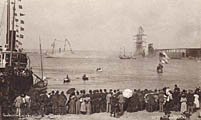The Journal of San Diego History
SAN DIEGO HISTORICAL SOCIETY QUARTERLY
July 1960, Volume 6, Number 3
Jerry MacMullen, Editor
By Manuel Madruga
 They don’t have fishermen’s races on the bay any more, but fifty years and more ago, these races were a big event, and everybody who wasn’t in the races, was watching them.
They don’t have fishermen’s races on the bay any more, but fifty years and more ago, these races were a big event, and everybody who wasn’t in the races, was watching them.
The fishing boats were what they called “Salmon boats” and they were double-ended with a big mainsail and a jib and a bowsprit. They had flush decks and a big hatch where they put the fish. By the time Fourth of July came around, everyone had a pretty good idea which was the best one, and they would pick two boats that had been racing, for the final championship race. I remember one year the people uptown picked the Gracie and the Portuguese fishermen at La Playa picked the Champion, which was owned by Mr. Frank Goularte. Before the race, we would pull them up on the shore and put shoe-polish on the bottom, and take out everything we could to make them lighter. The Gracie Was a good boat in heavy winds, but with the Champion being a lighter draft boat and the winds being light for the day of the race, the Champion had it all her own way and came in ahead.
After the race on Fourth of July, when it got dark, they would tie all the boats together, bow to stern, and would get the Santa Fe tug to pull them around the bay, off the Santa Fe wharf. The boats were all decorated with Chinese lanterns that the city furnished. Captain Polhamus used to be in charge of the lights, and he divided them up. He was a good promoter around the waterfront. His special favorites, though, were the girls’ rowing clubs. His daughter, Lena, was the one who organized the Zlac Rowing Club. Jerry Nichols built the first boat for the club. It was called a gig, and had eight oars.
Everyone that owned a boat joined in the Fourth of July celebration. They used to get one of Spreckels’ big lighters which were built by Telson to bring lumber into the shallow water wharves from the ships. They were about eighty feet long. They would decorate them with Chinese lanterns, and the City Guard Band would go aboard and play, while the Santa Fe towed the lighted fishing boats around for everyone to see.
The Zlacs weren’t the only ones who had gigs, or barges. The San Diego Rowing Club wanted me to build a boat for them, but at the time I was too busy, and a man named Daniel Romero built it. It was a nice boat, too, and it was clinker-built. The old State Normal School had a boat, and so did the Naval Reserves. That was an old Navy boat, and they used to get into some of the Navy races. Once there was a Japanese war vessel in port, and one of our ships, I think it was the old Charleston, invited them to race. The Japanese accepted, and what’s more, they won the race. There was nearly always a race on Fourth of July, between the Navy boats, if there happened to be a Navy ship in port then, and there generally was.
After the sail boats died out in the fishing fleet, they used to have races sometimes between the ones with power, and they could never catch the old Superior. I liked that, because I built the Superior.
EDITOR’S NOTE: Dean of the local boatbuilders, Manuel Madruga was born in Gloucester, Mass., in 1881 and came to San Diego with his parents at the age of three; he has literally grown up with the port. At one time working with the famous Manuel Goularte and with Chris Telson (who had worked on the Merrimac in Civil War days) he built boats in his own yard for several years, before joining the Campbell Machine Company in 1917, when the tuna fleet was in its infancy.







